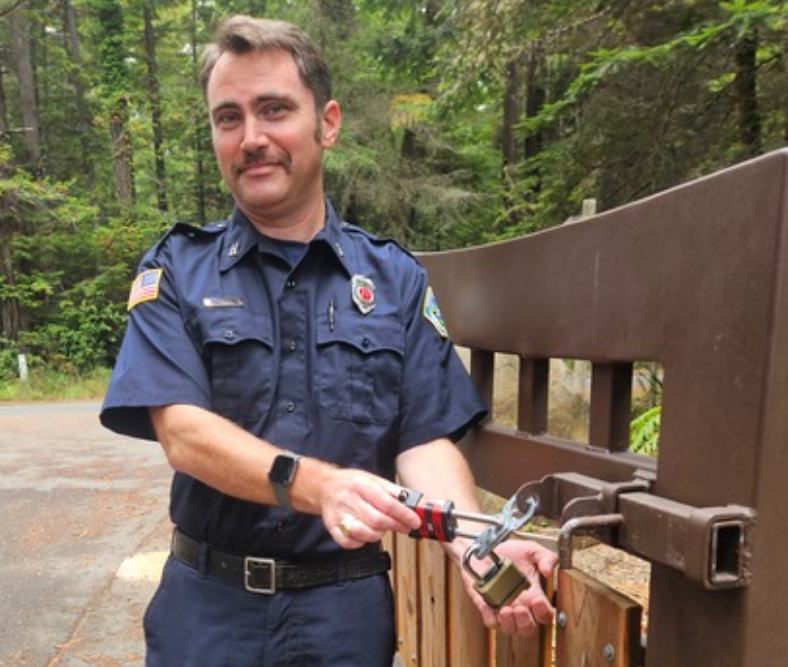MCFSC Micro-Grant Program Project Highlights
The Mendocino County Fire Safe Council will be accepting applications for Micro-Grants up to $12,500 from March 1–31. In just three years, the program, which is funded by the PG&E Corporation Foundation and Measure P sales tax revenue, has distributed over a quarter-million dollars to initiatives in dozens of communities to improve fire safety and resilience.
South Coast Fire Protection District Fire Captain William Thomas Kelly showing off the Knox Locks purchased through the MCFSC 2023 Micro-Grant Program
One of the most popular items that communities fund with the grant is water projects. MCFSC’s Outreach Coordinator Eva King reports that, “Fire departments often say it’s one of the most useful things that communities can do, especially down long, one-way in, one-way out roads.” Between the Micro-Grant cycles of 2022 and 2023, MCFSC helped fund nine water resource-development projects including tanks, standpipes and hydrants.
In 2023, the Hopland Fire Department placed one 2,500-gallon tank in McNab Ranch and another about six miles up Highway 175. Firefighters have already used one of these tanks to fight a structure fire and prevent it from spreading into wildlands. According to Hopland Fire Chief Mitch Franklin, the department has since purchased two more 2,500 gallon tanks with another Micro-Grant, and plans to install them in McNab Ranch by the end of February. He intends to apply for the grant each year to tuck more water tanks into more remote areas.
Fire departments get the most out of these awards by providing the labor to install the tanks. In Rancho Navarro, the MCFSC helped fund another water project that had also received a grant from the Community Foundation. Judy Long, president of the Anderson Valley Volunteer Firefighters Association, recalled that when her insurance bill shot up two years ago, she decided to install two 5,000-gallon tanks and a gravity-fed hydrant on her property in Rancho Navarro, making water available to well over 100 properties on about ten miles of road. The other closest water source is two miles away, which can be quite a distance when a water tender is sloshing slowly down a country road. The project started in 2023 with plenty of labor from the Anderson Valley Fire Department, which helped install the equipment and is training its responders on how to use it.
Another great project is the wildfire risk-assessment program implemented by Long Valley Fire Protection District’s Assistant Chief and Fire Marshall Greg Smith, who also runs the District’s training program. Using Micro-Grant funds, the Long Valley Fire Department implemented a wildfire-safety inspection and risk-abatement program. Smith says that the assessments have led to 80% compliance with fire-safety recommendations.
Though not everyone is delighted to be the recipient of a free home inspection, Smith says, “I think it’s been a huge success. We don’t do any fining or enforcement on our inspections”—although he may report egregiously dangerous conditions to CAL FIRE or County Code Enforcement. Basically, though, he reports, “Our inspections are a community education-based program.”
Some of Long Valley’s Micro-Grant funds have been used to hire high school students in an extracurricular program that regularly sends graduates to professional firefighting agencies. For inspections that take place after school, the students accompany Smith or the battalion chief and get paid minimum wage to observe the proceedings.
“We felt it was nice to have a second person with us as a witness,” Smith noted. “And they’re learning about the other end of the fire service: It’s not just about putting fires out—it’s about preventing them.” For the past two years, Smith’s small team has been going door-to-door in Laytonville and the surrounding countryside to carry out about 500 inspections, which include recommendations for improving fire resiliency. Some properties get a second inspection, so that homeowners have a chance to make improvements and have them checked. This may also improve their chances of getting a break on insurance.
If homeowners don’t make improvements, Smith says there may be worse consequences than getting fined. “After a second inspection,” he said, “if they’ve made no improvements, we just assume they’re not going to. If it’s really bad, we mark it on our run maps as potentially non-defendable, so we’re not wasting time in an emergency going in somewhere that we already know is not defendable (because) on these fires, you’re never going to have enough equipment,” especially in a wind-driven blaze like the recent fires in LA, or the 2017 Redwood Valley Complex and Tubbs fires. With limited resources, firefighting becomes a grim triage. “You need to make good choices on what you’re going to defend,” he said bluntly. “And unfortunately, you have to pick (the likeliest) winners.”
Fire departments and Neighborhood Fire Safe Councils or Firewise Communities can apply for Micro-Grants from the Mendocino County Fire Safe Council from March 1–31. Requests can range from $2,000 to $12,500. The final decisions will be made April 30, and approved grantees will have about one year to complete their projects.
MCFSC’s Eva King is offering technical assistance. “If anyone has questions or wants to brainstorm projects, they can reach out to me,” she offers. “Our applications are pretty straightforward—they aren’t too heavy of a lift. We tried to make it really accessible to Neighborhood Fire Safe Councils and people who aren’t used to applying for grants to be able to access this money.”
For more information, contact Eva King at king@firesafemendocino.org.
Applications and guidelines are now available on the Mendocino County Fire Safe Council’s Micro-Grant page at https://www.firesafemendocino.org/micro-grants


